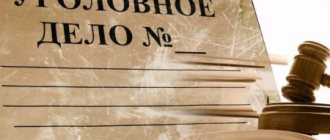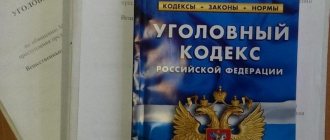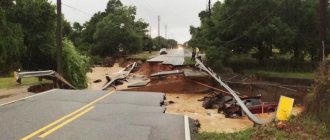What laws mention large and especially large damages?
Major damage and especially large damage are interpreted in the Criminal Code of the Russian Federation, since both of these criteria are necessarily taken into account when analyzing a criminal case and cannot be applied to administrative offenses.
Chapter 21 of the Criminal Code of the Russian Federation indicates specific amounts of money at which damage should be considered large and especially large, since it determines the preventive measures that are prescribed for crimes against property. This includes theft, robbery, robbery, fraud, etc.
Large and especially large damages are used to qualify criminal offenses.
These concepts are also found in Chapter 22 of the Criminal Code of the Russian Federation, which defines preventive measures for offenses in the economic sphere. These include crimes such as illegally obtaining a loan, market manipulation, etc.
Basically, companies and individual entrepreneurs become the subject here, so the amounts of damage can be much higher than those listed in Chapter 21.
What amounts constitute large and especially large damages?
Let us consider separately what amounts are defined by law as damage on an especially large scale and on a large scale, since these two criteria in their monetary equivalent have completely different meanings.
It’s worth noting right away that in case of fraud, the amount of damage will be exceptions to the generally accepted rule, so we will present them separately.
Major damage
The amount of major damage in the Criminal Code of the Russian Federation is defined in note 4 of Art. 158 ch. 21 and is designated as amounts exceeding RUB 250,000. , but further stipulates that they may be different for a certain group of offenses and range from 1,500,000 rubles . These are the crimes:
- fraud in the credit sector and using payment cards;
- offenses in the areas of insurance, business and computer technology.
Another separate exception is offenses in the field of non-fulfillment of an agreement in business activities. What amount is considered large in this particular case? From 3,500,000 rub.
The sizes of large and especially large sizes differ according to the types of offenses.
If we talk about ch. 22 of the Criminal Code of the Russian Federation, then according to it the amount of this type of harm is determined as an amount from 1,500,000 rubles. There are exceptions here too. For example, when limiting competition (Article 178 of the Criminal Code of the Russian Federation), how much is a large amount in the Criminal Code of the Russian Federation? In this case, the damage will be considered major if it is more than 10,000,000 rubles.
Particularly large damage
According to the Criminal Code of the Russian Federation, damage on an especially large scale is defined as an amount of more than a million rubles , but in 2012 some changes were made to the code, according to which it is considered an amount of 6 million rubles or more for fraud in the following areas:
- in credit;
- using payment cards;
- insurance;
- computer technologies.
4 years later, Art. ceased to apply. 159.4 of the Criminal Code of the Russian Federation for fraud in business activities. Instead, there are now h.ch. 6 and 7 art. 159, for which an especially large amount according to the Criminal Code of the Russian Federation is from 12 million rubles.
What Affects Relative Valuation
The assessment of damage is influenced by such criteria as the social danger of the crime committed, the market price of the object, etc. Now many lawyers note the need to introduce a differentiated approach to determining the amount of damage, since in some offenses it is not taken into account against whom they were committed - legal entities. or physical persons, as well as individual entrepreneurs.
Some crimes may also be of a continuing nature, as in cases of criminal acts by company accountants who engage in illegal cash flows over a long period of time. In these cases, the court will take into account the total amount of all improperly spent funds.
When assessing the value of property, sales receipts or other documents that contain information regarding the value of a citizen’s property must be taken into account. The financial condition of the citizen or organization at the time of the crime committed against them and the relationship between it and the amount of damage caused must also be taken into account
Reference. When the damage that has been caused to funds is determined (theft, robbery, fraud), then both cash and non-cash funds are taken into account, depending on which of them became the target of the criminal’s attack.
If these objects are of particular value from the point of view of art or history, then special experts are invited to evaluate them in monetary terms. They are the ones who determine it, and also take into account the importance of objects for society and culture.
To assess the damage, a special examination of the citizen’s property is carried out.
Experts are also invited to determine the cost of the vehicle. If we are talking about an accident, then you can contact an independent expert to accurately calculate the damage to the car. The resulting paper must be submitted to the investigation.
If during investigative activities a dispute arises over the assessment of damage, it is best to contact the same independent expert. However, here one point should be taken into account: the injured party, as the most interested in this issue, will most likely need to pay for his services.
Determination of the amount of damage. Features of collection
Shortage or damage to property may occur due to the fault of both third parties and employees of the institution. When determining the amount of damage to an institution, one should proceed from the market value of the lost property. This is the amount of cash that could be received as a result of the sale of these assets.
When recovering damages from employees of an institution, one must proceed from the norms of labor legislation, which largely limits their liability. Thus, the party to the employment contract (employer or employee) who caused damage to the other party compensates for it in accordance with the Labor Code and other federal laws.
According to Article 238 of the Labor Code, the employee is obliged to compensate the institution for direct actual damage caused. It refers to a real decrease in the institution’s property, a deterioration in its condition, as well as the need to incur costs for the purchase of new or restoration of damaged values. Lost income (lost profits) cannot be recovered from the employee.
Financial liability arises for damage caused as a result of culpable unlawful behavior (actions or inactions). In this case, each party to the employment contract is obliged to prove the amount of damage caused to it.
The Labor Code lists circumstances that exclude the financial liability of an employee. It does not arise, for example, when damage is caused due to force majeure circumstances, normal economic risk, extreme necessity or necessary defense, or the institution’s failure to fulfill its obligation to provide conditions for storing property entrusted to the employee.
The Code provides for two types of liability: limited and full. The employee’s full financial liability consists of his obligation to compensate for the damage caused in full.
Article 243 of the Labor Code establishes a list of grounds under which an employee may be held financially liable in the amount of damage caused. For example:
- shortage of valuables entrusted to the employee on the basis of a written agreement or received by him under a one-time document;
- intentional causing of damage;
- causing damage while under the influence of alcohol, drugs or other toxic substances;
- causing damage as a result of criminal actions established by a court verdict;
- causing damage as a result of an administrative violation, if established by the relevant government body.
If there are no grounds for bringing full financial liability, then the employee bears financial liability for damage caused to the employing institution only within the limits of his average monthly earnings (limited liability).
This is stated in Article 241 of the Labor Code. An employee can compensate for damage exceeding this limit only voluntarily or by court decision. Before holding any of the employees financially liable, the employer is obliged to conduct an inspection. During it, the amount of damage caused and the reasons for its occurrence are determined. For such verification, a commission is created with the participation of relevant specialists.
The amount of damage for loss and damage to property is determined by actual losses, calculated on the basis of market prices prevailing in the area on the day the damage occurred. Moreover, according to the norms of labor legislation, the amount of damage should not be lower than the value of the property according to the accounting records of the institution (taking into account its wear and tear). This rule also applies provided that the book value of the assets is zero. For example, if we are talking about a lost fixed asset that was completely depreciated.
Expert opinion
A. Arzamastsev, expert of the Legal Consulting Service GARANT
A. Kikinskaya, reviewer of the Legal Consulting Service GARANT
The value of property according to accounting data is only the lower limit of the amount of damage that the employer has the right to recover from the guilty employee. Article 246 of the Labor Code of the Russian Federation allows you to recover damages from an employee based on the market prices of lost property in force in the area on the day the damage was caused. The employer must determine the market price of the lost property independently. It is he who is responsible for proving the size of the market value.
To establish the cause of damage, it is mandatory to request a written explanation from the employee. If the employee refuses or evades his representation, a corresponding act is drawn up. It is signed by the employees of the institution.
Based on the results of the inspection, documents are drawn up that record the fact of damage, its size and causes. There are no standardized forms for such documents. In practice, damage is documented in a protocol, an inventory report, or an expert opinion. The documents are signed by members of the commission. It may include the employees who conducted the inspection.
If the amount of damage does not exceed the average monthly salary, recovery from the guilty employee is carried out by order of the head of the institution. In this case, the restriction on the one-time collection of a particular amount from earnings, established by Article 138 of the Labor Code, must be observed. The total amount of all deductions should not exceed 20 percent of the earnings due for payment.
The order is issued no later than one month from the date the amount of damage is determined. If this period has expired or the employee does not agree to voluntarily compensate for the damage caused, and its amount exceeds the employee’s average monthly earnings, then recovery can only be carried out by a court decision.
URGENTLY!
Hurry up to understand FSBU 5/2019 “Inventories” before you are fined . The easiest way is a short but complete advanced training course from accounting guru Sergei Vereshchagin
- Duration 25 hours for 1 month
- Your ID in the Rosobrnadzor register (FIS FRDO)
- We issue a certificate of advanced training
- The course complies with the professional standard “Accountant”
View full program
Amount of damage as a qualifying feature
Damage acts as an object as a qualifying feature in crimes. Usually these are funds or property that caused damage. It may also be the subject of an offense.
In some cases, it is also considered as an objective aspect of the crime , namely as causing large or especially large damage. It is precisely this kind of formulation that is often found in this case.
When qualifying crimes against property or in the economic field, it is necessarily taken into account, since it is considered a kind of measure for assessing the consequences that occurred as a result of the offense, as well as assessing its social danger.
Important! The amount of damage directly affects the choice of the preventive measure itself and the duration.
Usually in criminal practice the following principle applies: the more harm a citizen has suffered, the more severe the punishment will be imposed on the perpetrator of the incident. In some cases, the latter is also required to pay compensation for damage.
The amount of damage directly affects the type and amount of punishment imposed.
Thus, we can conclude that this is a very important qualifying feature in crimes that are characterized as committed against property or in the economic sphere.
What crimes does it characterize?
Such a qualifying feature as the amount of damage characterizes crimes against property and relates to the classification of crimes according to the subject of the attack. In this category of offenses, the amount of damage is of significant importance. If it is minor, then the offense does not fall within the scope of the Criminal Code.
The greater the amount of damage, the higher the degree of danger of the act and the punishment becomes more severe. Property crimes include:
- theft;
- robbery;
- robbery;
- extortion;
- theft of valuables;
- illegal taking of a car;
- various types of fraud.
Is it possible to challenge the amount of damage?
It is possible to challenge the damage received, but you will need to provide the court or investigation with comprehensive evidence that the real amount does not correspond to that obtained as a result of the expert assessment.
Here we need to consider the standards that the experts relied on when conducting the examination itself. It is possible that they are outdated or do not correspond to the real state of affairs. In this case, you should always request copies of their assessment for consultation with an experienced lawyer.
You can also order your own independent examination, but you will have to pay for it, since you are more interested in this than the culprit himself.





